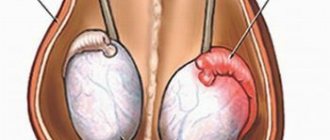Why does the vagina hurt?
Medical manipulations
Painful sensations are observed after abortion and diagnostic curettage. May cause concern after installation of an intrauterine device and hysteroscopy. Itching, mild or moderate, decreases and disappears within a few hours or days. The cause of periodic dull or nagging pain is cicatricial changes in the vagina after surgery, incisions and ruptures during childbirth.
Traumatic injuries
Minor injuries occur due to unsuccessful douching, the use of uterine rings and tampons that are not the right size. The latter option is more often observed in teenage girls and young girls. Sometimes the cause of superficial damage is careless sexual intercourse or an unphysiological position of the woman’s body during intercourse. There is no bleeding, the pain is not intense and disappears quickly.
The etiological factors of vaginal ruptures outside the period of labor are violent or overly aggressive sexual contacts, drug or alcohol intoxication of partners, rough use of intimate accessories or foreign objects to obtain satisfaction. The presence of a serious lesion is indicated by bleeding and sharp pain.
Severe combined injuries can be observed with birth ruptures and pelvic fractures due to high-energy impacts. Along with the vagina, the uterus, perineal area, and neighboring pelvic organs are affected. The clinical picture is determined by the nature and extent of the damage. Intense sharp cutting pain, shock, and massive blood loss are observed. The condition is life-threatening.
Soft vaginal foreign bodies and small foreign objects are usually not painful. The appearance of pain, which intensifies during urination and sexual intercourse, is possible with prolonged irritation of the mucous membrane and the development of inflammation. Sharp and hard objects injure the walls of the organ; the same clinical picture is observed as with vaginal ruptures.
Vaginitis
For acute colpitis, dull, low-intensity pressing or bursting pain in the vaginal area is typical. Urination and sexual intercourse are accompanied by an increase in pain, the pain becomes more acute, sometimes cutting or stabbing. Irritation, itching, swelling, hyperemia, local hyperthermia of the vagina and vulva are noted.
With coccal vaginitis, the discharge is copious, yellowish-white, with gardnerellosis - transparent, smelling of rotten fish. In patients with thrush (vaginal candidiasis), a heterogeneous, curd-like white discharge is noted. Along with infection by opportunistic microorganisms, colpitis develops with tuberculosis and the following STIs:
- gonorrhea;
- syphilis;
- chlamydia;
- trichomoniasis;
- mycoplasmosis and ureaplasmosis.
The downward spread of infection leads to the occurrence of vulvovaginitis, in which the above symptoms are combined with pain, irritation and redness of the labia, clitoris, perineum, buttocks and inner thighs. In patients with chronic vaginitis, pain occurs extremely rarely. They may appear during exacerbations of pathology after hypothermia and acute respiratory viral infections, during pregnancy or during menstruation.
Vaginal condylomas
Endometriosis
For patients with endometriosis, pressing, pulling and bursting pains are mainly bothered during sexual intercourse, defecation and urination, especially when the lesions are located in the vagina, rectouterine cavity, area of the uterosacral ligaments and rectovaginal septum. In approximately 20% of cases, there is a combination with localized or diffuse pelvic pain, in 40-60% of cases - with dysmenorrhea. Possible menorrhagia, posthemorrhagic anemia, infertility.
Volumetric formations
Nagging or contact pain is more often observed with true benign neoplasms of the vagina: lipomas, fibroids, fibromas, fibromyomas. They are supplemented by unpleasant sensations during sexual intercourse, a feeling of a foreign body, and disorders of urination and defecation. In rare cases, pain during sitting, walking, physical activity and sexual intercourse is observed in women with large cysts of the vagina and Gartner's duct.
Rapidly growing intense pain in the vagina, pubis, perineum, lower abdomen is detected with malignant neoplasia - cancer and sarcoma. There are purulent, bloody or bloody discharge, contact and spontaneous bleeding, urinary disorders, constipation or fecal incontinence, swelling of the lower extremities. Common symptoms are weakness, loss of appetite, weight loss, nausea, vomiting.
Dyspareunia
The cause of pain is the insertion of the penis into the vagina or friction. Sometimes pain occurs already at the stage of arousal or only after completion of intercourse. Painful sensations vary greatly and can be weak, barely noticeable, or painful, unbearable, stabbing, aching or burning. Covers only the vagina or vagina and vulva. Depends on the position and circumstances of copulation.
Dyspareunia can be combined with vulvodynia. Often accompanies vaginitis, vulvitis and vulvovaginitis. In addition, it is provoked by the following gynecological pathologies:
- bartholinitis;
- vaginal malformations;
- atrophic colpitis;
- uterine fibroids;
- retroflexion of the uterus.
It is found during adhesions and varicose veins of the small pelvis. Identified in interstitial cystitis and Sjögren's syndrome. Sometimes it is formed as a result of allergic reactions and microtraumas when using contraceptives. May be due to improper partner technique or psychological factors.
Prolapse of the genital organs
Discomfort and dull pressing pain bother women with prolapse of the vagina or uterus. They are supplemented by a sensation of a foreign body, nagging pain in the lower abdomen, and in a third of patients they are combined with dyspareunia. Possible bloody discharge from the vagina, mixed urination disorders, colitis, constipation, involuntary discharge of gases. When the uterus prolapses, infertility, algomenorrhea and hyperpolymenorrhea are often observed.
Hematocolpos
Hymenal atresia is asymptomatic until menarche. After the onset of menstruation, periodic spasmodic painful sensations are noted in the lower abdomen and lumbar area. A few months later, after a large amount of blood accumulates in the vagina, girls experience bursting pain in the vagina, caused by pressure on the walls of the organ. With hematocolpos against the background of vaginal aplasia and atresia, pain begins to disturb after the first or second menstruation, and sooner it becomes constant.
Fistulas
Painful sensations, itching and burning of the vagina are observed in patients with rectovaginal fistulas due to infection. The pain intensifies during sexual intercourse and forces the woman to refuse sex. There is the release of gases and feces through the vagina, and a constant smell of feces. With urethro-vaginal and vesicovaginal fistulas, the symptom is less disturbing; dysuric disorders and urine leakage through the vagina come to the fore.
Other reasons
Sometimes the symptom is provoked by diseases of nearby organs or has a psychological basis. The cause of pain is:
- Proctological pathologies:
hemorrhoids, proctitis, paraproctitis, perianal abscess, suppurating coccygeal tract, thrombosis of hemorrhoids, rectal tumors. - Diseases of the urinary system:
urethritis, cystitis. - Mental disorders:
hysteria, neurasthenia, obsessive-compulsive disorder, some psychotic states.
Colposcopy
Causes of gynecological diseases
The occurrence of gynecological diseases is promoted by:
- failure to comply with the rules of personal hygiene and sexual hygiene;
- alcoholism, drug addiction;
- active sex life with different sexual partners;
- use of irrational contraceptives;
- douching with various chemicals;
- temperature effects on the vaginal mucosa;
- sexual activity during menstruation;
- frequent abortions;
- endocrine, congenital, infectious diseases, especially in childhood;
- diseases of the urinary system, intestines;
- metabolic disorders;
- stress;
- eating disorders.
The consequences of early onset of sexual activity are especially unfavorable when defense mechanisms are not fully formed.
Diagnostics
Diagnostic measures are carried out by a gynecologist. If necessary, a sexologist, psychologist, oncologist, and other specialists are involved in the examination. During the interview, the doctor examines the obstetric and gynecological history, finds out how long ago and under what circumstances pain in the vagina first appeared, how the symptom changed over time, and what manifestations it was combined with. To clarify the nature of the pathology, the following methods are used:
- Gynecological examination.
It is possible to detect inflammation, space-occupying processes, prolapse of the internal genital organs, developmental anomalies, traumatic injuries, and cicatricial deformities. Sometimes a rectal-abdominal or rectal-vaginal examination is performed. - Colposcopy.
The doctor examines the vagina and cervix under a microscope, detects defects in the mucous membrane, and examines space-occupying formations. According to indications, performs a targeted biopsy for subsequent morphological analysis of a tissue sample. - Ultrasonography.
During a combined ultrasound, a comprehensive picture of the state of the pelvic structures is obtained, developmental defects, post-traumatic changes, and adhesions are determined. If there are signs of varicose veins, an additional ultrasound examination of the vessels is performed. If pathology of neighboring organs is suspected, an ultrasound of the rectum, urethra, and bladder is performed. - Lab tests.
A smear examination helps clarify the composition of the microflora in vaginitis. To determine the pathogen and its sensitivity to antibiotics, culture is carried out on nutrient media. For STIs, PCR tests are used. Biopsies are studied during histological or cytological examination. - Other methods.
To exclude damage to neighboring organs, rectoscopy, cystoscopy, urethroscopy, ultrasound of the kidneys and ureters, consultation with a proctologist or urologist may be required.
Symptoms of gynecological diseases
All gynecological diseases are accompanied by specific symptoms , the most characteristic of which are:
- pathological secretion;
- disturbances of menstrual and sexual functions (for example, pain during sexual intercourse, most often caused by the inflammatory process of the uterine appendages);
- reproductive dysfunction (for example, spontaneous miscarriages), infertility.
Menstrual dysfunction can manifest itself in a variety of forms: hypo- or hypermenstrual syndrome, amenorrhea, menorrhagia, algomenorrhea, anovulation (lack of ovulation).
Treatment
Conservative therapy
The list of therapeutic measures is determined by the etiology of pain in the vagina:
- Vaginitis.
Antibacterial, antiviral and antifungal agents of general and systemic action are recommended. Antiseptic ointments and vaginal suppositories, disinfectant solutions, sitz baths with herbal decoctions, potassium permanganate solution, and furatsilin are used. - Endometriosis.
The leading role is played by hormone therapy using agonists of gonadotropic releasing hormones, gestagens, antigonadotropic and combined estrogen-progestogen drugs. It is possible to prescribe medications with anti-inflammatory effects, analgesics, antispasmodics, and immunostimulants. - Dyspareunia.
In the presence of causative organic pathologies, local anesthetics, hormone replacement therapy, sedative and anti-inflammatory drugs, physiotherapy, and gynecological massage are used. For psychogenic dyspareunia, psychocorrection is carried out using various techniques. - Prolapse of the uterus and vagina.
A special diet, Kegel exercises, gymnastics according to Atarbekov, and estrogen-containing drugs are indicated. Individually selected gynecological pessaries are used to support the organs. - Malignant neoplasms.
Photodynamic therapy, chemotherapy or radiation therapy using interstitial, intracavitary or external irradiation are required.
Surgery
Taking into account the nature of the disease, the following surgical interventions can be performed:
- Traumatic injuries:
suturing of vaginal ruptures, opening of submucosal hematomas, removal of foreign bodies, laparotomy and revision of the abdominal cavity with combined damage to several organs. - Endometriosis:
laparoscopic endocoagulation, excision of retrocervical endometriosis, organ removal interventions for common pathology in patients of the older age group. - Organ prolapse:
colporrhaphy, vaginopexy with MESH prosthesis, sling operations, colpocleisis, various options for vaginoplasty. - Hematocolpos:
emptying and sanitation of hematocolpos, hymenotomy, excision of the vaginal septum, vaginoplasty, excision of the wall of the “blind” vagina. - Fistulas:
excision of rectovaginal, urethro-vaginal and vesicovaginal fistulas, levatoroplasty, sphincteroplasty. - Volumetric formations:
removal of a benign tumor, excision of a cyst, electroexcision, vaginectomy and hysterectomy for malignant neoplasia.
Prevention of gynecological diseases
Prevention of gynecological diseases includes:
- protecting the health of girls from the period of intrauterine development;
- timely treatment of infectious and other diseases;
- timely treatment of the consequences of birth injuries;
- healthy lifestyle, giving up bad habits, hardening;
- compliance with the rules of general hygiene and genital hygiene.
In gynecology, there are several mandatory principles for effective work for the benefit of women. Timely consultation in gynecology is necessary to avoid serious problems in the future, because female diseases, like all others, are treatable the better the earlier they are identified.








